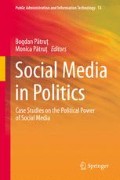Abstract
India, the second most populous country in the world, is also a country with a very high percentage of youngsters. Social media are popular amongst Indian youngsters. People of the 15–35 age groups use them in a higher percentage especially in urban areas. Social network websites, YouTube, Facebook and Twitter are the most popular, but some young people also write on blogs. Initially used for making online friendship, developing relationships, business contacts and interacting with global masses, social media have recently been used for mobilizing youngsters for revolutions and riots. India has witnessed different agitations and road protests in cities like New Delhi, Mumbai and Bangalore in 2011–2012 and 2013. During the Anti Corruption Movement and Mass Agitation against Delhi Gang rape, social media were fully exploited to mobilize people, to gather them and to raise voice against injustice and the faulty system responsible for high-level corruption and poor law and order situation in cities. But, in some other cases, they also served for spreading rumors, misinformation and creating panic and chaos amongst common people, specifically during the Ethnic Conflicts in Assam in 2012 and, recently, in 2013, during the communal riots in Muzaffarnagar. Domestic and cross-border anti-elements, non-state actors misused social media to disturb law and order by spreading rumors and uploading false content and images on the internet. In this chapter, the author has tried to understand the nature of these four events, the role of social media in positive and negative message creation and circulation, the patterns of information flow on social media and the impact of social media messages.
Access this chapter
Tax calculation will be finalised at checkout
Purchases are for personal use only
Notes
- 1.
Anna Hazare’s “India against Corruption: Role of New Media in Mass Movement,” http://sciencesblog.org/management/anna-hazares-india-against-corruption-role-of-new-media-in-mass-movement/, Accessed on May 8, 2013.
- 2.
2013 India Internet outlook, http://techcircle.vccircle.com/2013/02/01/2013-india-internet-outlook/, Sandeep Aggarwal, February 1, 2013, Accessed on May 14, 2013.
- 3.
Why only 3 % of India has home internet access, http://qz.com/66146/why-only-3-of-india-has-home-internet-access/, Tim Fernholz, March 22, 2013, Accessed on May 14, 2013.
- 4.
Study says social media revolution set to get bigger, http://www.thehindu.com/sci-tech/technology/internet/study-says-social-media-revolution-set-to-get-bigger/article4516369.ece, Ramya Kannan, March19, 2013, Accessed on May 8, 2013.
- 5.
Welcome to the social media revolution, http://www.bbc.co.uk/news/business-18013662, May 10, 2012, Accessed on May 8, 2013.
- 6.
Delhi gang rape: Social media exposes governments manhandling of truth, http://janamejayan.wordpress.com/2012/12/30/delhi-gang-rape-social-media-exposes-govts-manhandling-of-truth/, posted on December 30, 2012, Accessed on May 15, 2013.
- 7.
Anna Hazare’s “India against Corruption: Role of New Media in Mass Movement,” http://sciencesblog.org/management/anna-hazares-india-against-corruption-role-of-new-media-in-mass-movement/, Accessed on May 8, 2013.
- 8.
U.K. riots reveal social media double standard, http://www.cbc.ca/news/world/story/2011/08/10/social-media-riots.html, Prithi Yelaja, August 10, 2011, Accessed on May 14, 2013.
- 9.
A year of social activism in India, http://www.indiatribune.com/index.php?option=com_content&view=article&id=7599:a-year-of-social-activism-in-india&catid=107:coverpage&Itemid=471, Accessed on May 20, 2013.
- 10.
Analyzing Social Media Momentum, India’s 2011–2012 Anticorruption Movement, U.S. Government Office of South Asia Policy, Sasha Bong, Kenneth Chung, Karen Parkinson, Andrew Peppard, Justin Rabbach, Nicole Thiher, Workshop in International Public Affairs, University of Wisconsin System, Spring 2012, updated on page 4 on January 3, 2013, Accessed on May 20, 2013.
- 11.
Anti-Corruption Movement: Part 1, http://alteranation.com/topic-details.aspx?topicid=7, February 28, 2013, Accessed on May 8, 2013.
- 12.
Anna Hazare’s “India against Corruption: Role of New Media in Mass Movement,” http://sciencesblog.org/management/anna-hazares-india-against-corruption-role-of-new-media-in-mass-movement/, Accessed on May 8, 2013.
- 13.
Anna Hazare, http://timesofindia.indiatimes.com/topic/Anna-Hazare, Accessed on May 8, 2013.
- 14.
Anna Hazare’s “August Kranti” on Facebook—a Case Study, http://www.indiadigitalreview.com/article/anna-hazares-august-kranti-facebook-%E2%80%93-case-study, Sandeep Amar, Head - Marketing and Audience, Indiatimes, Accessed on May 8, 2013.
- 15.
The impact of Social Media, http://www.thesundayindian.com/en/story/the-impact-of-social-media-/31/27616/, January 8, 2012, Accessed on May 8, 2013.
- 16.
http://www.civilserviceindia.com/subject/Essay/anna-hazare-movement-against-corruption%20.html, Accessed on May 20, 2013.
- 17.
Are we ready for a social revolution, http://www.indiaonward.com/inclusive-society/are-we-ready-for-a-social-revolution/, Virginia Sharma, accessed on May 8, 2013.
- 18.
Protest against Delhi Gang Rape intensifies on Social Media, http://efytimes.com/e1/fullnews.asp?edid=97483, EFYtimes News, Accessed on May 15, 2013.
- 19.
India Asks Pakistan to Investigate Root of Panic, http://www.nytimes.com/2012/08/20/world/asia/india-asks-pakistan-to-help-investigate-root-of-panic.html, Jim Yardley, August 19, 2012, Accessed on May 20, 2013.
- 20.
India Debates Misuse of Social Media, Anjana Pasricha, August 21, 2012, http://www.voanews.com/content/india-debates-misues-of-social-media/1492129.html, Voice of America, Accessed on February 20, 2013.
- 21.
See footnote 1.
- 22.
India blames Pakistani social media activists for causing Assam unrest, http://www.moremag.pk/2012/08/23/india-blames-pakistani-social-media-activists-for-causing-assam-unrest, Mudassir Jehangir, August 23, 2012, Accessed on March 19, 2013.
- 23.
India Debates Misuse of Social Media, http://www.voanews.com/content/india-debates-misues-of-social-media/1492129.html, Anjana Pasricha, August 21, 2012, Accessed on February 20, 2013.
Author information
Authors and Affiliations
Corresponding author
Editor information
Editors and Affiliations
Rights and permissions
Copyright information
© 2014 Springer International Publishing Switzerland
About this chapter
Cite this chapter
Bute, S. (2014). The Role of Social Media in Mobilizing People for Riots and Revolutions. In: Pătruţ, B., Pătruţ, M. (eds) Social Media in Politics. Public Administration and Information Technology, vol 13. Springer, Cham. https://doi.org/10.1007/978-3-319-04666-2_19
Download citation
DOI: https://doi.org/10.1007/978-3-319-04666-2_19
Published:
Publisher Name: Springer, Cham
Print ISBN: 978-3-319-04665-5
Online ISBN: 978-3-319-04666-2
eBook Packages: Humanities, Social Sciences and LawPolitical Science and International Studies (R0)

